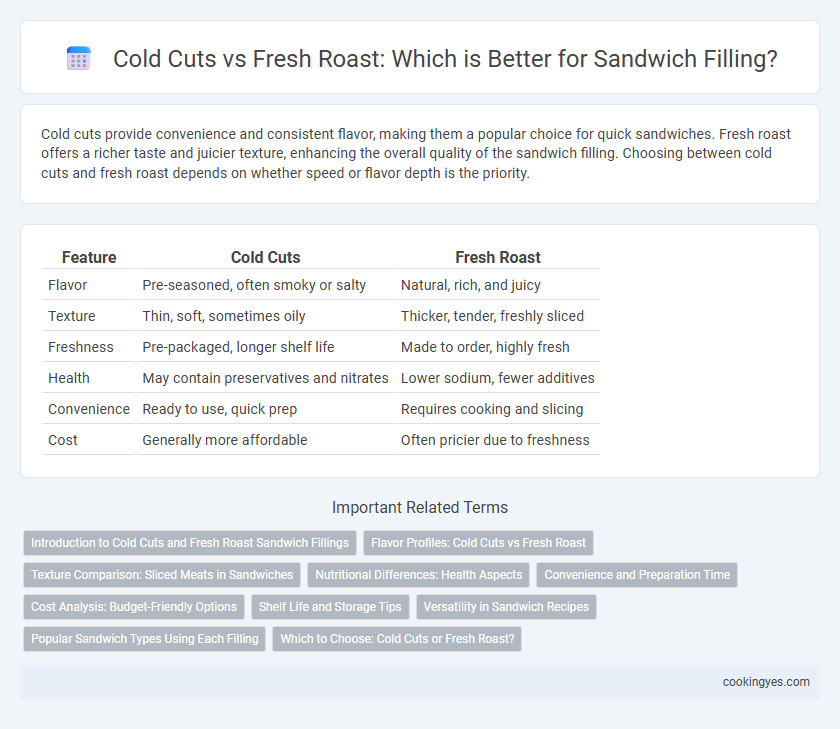Cold cuts provide convenience and consistent flavor, making them a popular choice for quick sandwiches. Fresh roast offers a richer taste and juicier texture, enhancing the overall quality of the sandwich filling. Choosing between cold cuts and fresh roast depends on whether speed or flavor depth is the priority.
Table of Comparison
| Feature | Cold Cuts | Fresh Roast |
|---|---|---|
| Flavor | Pre-seasoned, often smoky or salty | Natural, rich, and juicy |
| Texture | Thin, soft, sometimes oily | Thicker, tender, freshly sliced |
| Freshness | Pre-packaged, longer shelf life | Made to order, highly fresh |
| Health | May contain preservatives and nitrates | Lower sodium, fewer additives |
| Convenience | Ready to use, quick prep | Requires cooking and slicing |
| Cost | Generally more affordable | Often pricier due to freshness |
Introduction to Cold Cuts and Fresh Roast Sandwich Fillings
Cold cuts, also known as deli meats, include pre-cooked or cured slices like ham, turkey, salami, and roast beef, offering convenience and variety for sandwich fillings. Fresh roast refers to meats roasted and sliced just before serving, providing a juicier texture and richer flavor profile ideal for sandwiches. Choosing between cold cuts and fresh roast impacts sandwich freshness, taste complexity, and preparation time.
Flavor Profiles: Cold Cuts vs Fresh Roast
Cold cuts offer a savory, salty flavor profile with a tender texture due to their curing and aging processes, providing a consistent taste ideal for classic deli sandwiches. Fresh roast, on the other hand, delivers a richer, more robust flavor with natural juiciness and a firmer bite, enhancing sandwiches with a home-cooked appeal. Choosing between the two depends on preference for either the subtle complexity of cold cuts or the hearty depth of freshly roasted meats.
Texture Comparison: Sliced Meats in Sandwiches
Cold cuts offer a consistent, tender texture that slices thinly, creating smooth layers easily folded into sandwich bread. Fresh roast meats typically provide a denser, chewier bite with varying thickness, enhancing the sandwich with more pronounced muscle fiber texture. The difference in texture between cold cuts and fresh roast fillings directly impacts the overall mouthfeel and structural integrity of the sandwich.
Nutritional Differences: Health Aspects
Cold cuts often contain higher levels of sodium, preservatives, and nitrates, which can negatively impact heart health and contribute to inflammation. Fresh roast meat typically provides superior nutritional benefits, including lower sodium content, fewer additives, and higher protein quality, supporting muscle maintenance and overall health. Choosing fresh roast fillings over processed cold cuts can reduce exposure to harmful substances and promote better nutrient density in sandwiches.
Convenience and Preparation Time
Cold cuts offer unmatched convenience for sandwich fillings due to their pre-sliced packaging, enabling quick assembly without extra preparation. Fresh roast requires cooking and slicing, significantly increasing preparation time and effort. For busy schedules, cold cuts provide a time-efficient option without compromising flavor variety.
Cost Analysis: Budget-Friendly Options
Cold cuts offer a budget-friendly option for sandwich fillings due to their lower price per pound and longer shelf life compared to fresh roast meats. Fresh roasts, while providing superior flavor and texture, tend to be more expensive and require immediate consumption to prevent spoilage. Choosing cold cuts can significantly reduce sandwich preparation costs without sacrificing variety, making them ideal for cost-conscious consumers.
Shelf Life and Storage Tips
Cold cuts typically have a shorter shelf life of 3 to 5 days when stored in the refrigerator at or below 40degF (4degC), whereas fresh roast meats can last up to 7 days under the same conditions. To maximize freshness, cold cuts should be kept in airtight containers or tightly wrapped in plastic wrap to prevent exposure to air and moisture. Fresh roast sandwiches benefit from refrigeration within two hours of preparation and can be frozen for longer-term storage up to 2 months, ensuring optimal taste and safety.
Versatility in Sandwich Recipes
Cold cuts offer unmatched versatility in sandwich recipes with a wide range of flavors, from smoky salami to mild turkey, enabling quick and easy preparation. Fresh roast adds a hearty, rich texture and allows customization in thickness and seasoning, providing a more gourmet touch to sandwiches. Combining cold cuts and fresh roast gives endless possibilities to create balanced, flavorful sandwiches that suit varied tastes and dietary preferences.
Popular Sandwich Types Using Each Filling
Cold cuts such as ham, turkey, and salami are commonly used in classic sandwiches like the Italian sub and turkey club, offering convenience and a balanced flavor profile. Fresh roast fillings, including roast beef and freshly roasted chicken, are favored in gourmet sandwiches like the French dip and roast beef melt due to their robust texture and rich taste. Both filling types cater to diverse preferences, enhancing the sandwich experience through varied textures and flavors.
Which to Choose: Cold Cuts or Fresh Roast?
Cold cuts provide convenience and a consistent flavor profile, saving preparation time for quick sandwiches. Fresh roast offers superior taste and texture due to its higher moisture content and minimal processing, making it ideal for gourmet or healthier sandwich options. Choosing between cold cuts and fresh roast depends on whether convenience or quality is the priority for your sandwich filling.
Cold cuts vs fresh roast for sandwich filling Infographic

 cookingyes.com
cookingyes.com